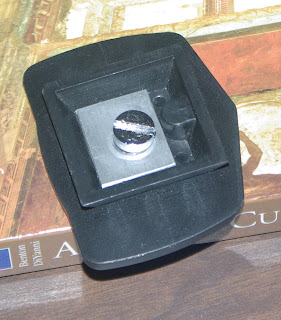Now that the semester is over, and I do not seem to have any classes for next semester, I am starting to work on the various little tasks that have been annoying me to get them done.
1. A while back, the mounting plate for my camera tripod failed. Probably because I was a bit paranoid about a $1000 camera falling off of it, I had tightened the 1/4"-20 screw that holds the plate to the camera a bit too tightly, and eventually, the screw cut right through the plastic. I tried to find a replacement, but this plate seemed to be in between two sizes (a problem that last time I bought one, required a bit of sanding to make the plate fit my tripod).
I have been thinking of machining a replacement mounting plate out of aluminum, that my great-grandchildren would probably be able to use. When I spent a couple of my spare minutes today looking at it, I realized that what I really needed was not a complete replacement, but just a metal patch on the bottom of the plate, to fill in the hole in the plastic.
I rather overdid this. I started with a scrap piece of .10" thick aluminum, and machined it to a 0.85" x 1.10" rectangle (exactly the size to fit in the bottom of the plate). Then I drilled a 0.25" hole for the 1/4"-20 screw to go through. I epoxyed the plate to the bottom. The screw is actually held in place by the flexible rubber on the top of the plate. Voila! Problem solved!
2. I have a few more wired Ethernet connections than I had ports on the back of my D-Link router. I mentioned back in August that part of the Frankenstein cabling system that I had included a 10Base-T router that had been scrapped by HP shortly after I started work there in 2001. While this worked, it also slowed any Ethernet connections through that bridge down to 10 Mbps--so any wired connections there were slower than the wireless connection.
I scrapped the antique--but it also meant that at least two of my wired connections could not be connected. My dual boot Linux/Windows notebook was only running on wireless, which meant inferior file transfer speeds on Sunday mornings, when we move the worship service from my wife's desktop to the notebook. In addition, the far end of the house has a wired connection for when we have visitors staying. Admittedly, we have not had many visitors, but it seemed silly to have a cable going there but nothing connected.
There is an almost antique Linksys wired router here--one that has eight LAN connections on the back. I found this really useful description of the steps required to convert a wired router into a bridge, and sure enough, it worked perfectly. Now I have every wired connection (an inkjet all-in-one, a LaserJet all-in-one, two notebooks, my wife's desktop, and the remote bedroom) operational, and six wired ports to spare!
3. I am going to try and write at least and submit at least one article to PJMedia every day. It has become considerably harder to get published there in the last few months, at least partly because they have so many interesting and important people writing for them. Much like the secret of being a great photography--take lots of pictures, and throw most of them away--the trick to getting articles published is write many, get a few accepted, and the rejects get inflicted on all of you.
4. It is time to again find the public domain finite element modeling software that I saw last year, so that I can use it to verify that six one-inch, .050" wall tubes will make a sufficiently stiff half-Suerrier truss for Big Bertha's final rebuild.

I also have recently had a networking success when I FINALLY found correct information (after nearly a decade) on how to connect my XP pc to my ancient Apple 12/640. There are so many sites giving advice that is WRONG. But a University of Pennsylvania AG school IT site had instructions so simple and perfect they worked the first time.
ReplyDeleteAnd the URL of that site was?
ReplyDeleteAh, I remembered wrong, it was PennState.
ReplyDeletehttp://agsci.psu.edu/it/how-to/set-up-high-end-apple-printer-on-your-windows-xp-computer
The two vital bits of data I was missing is that you set it up as an LPR printer, which I was always blocked at doing because I missed the second, even MORE important bit of data: to name the Queue "RAW". The name isn't important to the printer other than indicating the data type. And I couldn't find that bit anywhere else, not even the manual, except in the Unix section, where it was lower case and wouldn't work. Windows will try to talk to the queue while you set it up, so if you don't have that "RAW", and say, try to use the printer name, it will fail.
Other websites would go through the whole process of configuring a remote IP port, but not specify the, uh, port of the port (LPR is 515, but some Apple printers don't care). The 515 I only found on a deprecated Apple support article that you can't get to through the root of Apple's current support site. And in any case, that's barking up the wrong tree.
I had already assigned a fixed network address to the printer ages ago.